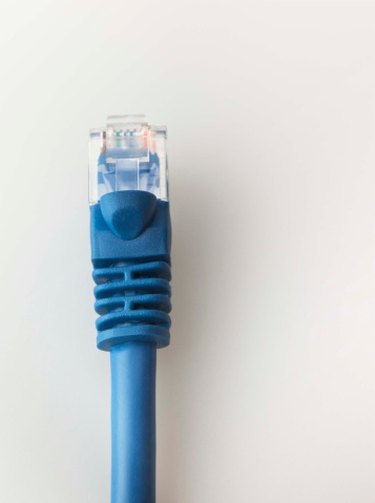
Category 3 (Cat3) and Category 5 (Cat5) are the two most common network cable specifications in use, as of 2011. Found in both the office and the home, the two cables have different physical characteristics. A Cat5 cable generally features a thicker cable diameter and an RJ45 connector. A Cat3 cable is typically thinner and features a smaller RJ11 or RJ24 connector. Cables usually have their specifications printed along the plastic covering at regular intervals to aid easy identification.
History
Video of the Day
Cat3 cables were the industry standard in the early 1990s, with faster speeds and greater bandwidth than the older Cat2 specification. Their primary use was in token ring and simple 10Base-T networks. A Cat4 cable standard was introduced as an improvement to Cat3, but was short lived due to the release of Cat5 cable, which featured a 10-fold increase in speed and improved bandwidth.
Video of the Day
Cable Speed
Cat3 cable features a 10 megabits per second (Mbps) transfer rate, operating at 16 megahertz (MHz). Cat5 cable offers a 100 Mbps transfer rate, operating at 100 MHz, making it effectively 10 times faster than Cat3. However, those are optimal speeds in an ideal setting. In practice, speeds observed will be reduced slightly, typically due to outside interference, the length of the cable or improper installation leading to creases or bends in the cable.
Cable Cost
Both Cat3 and Cat 5 cables share a similar construction, featuring pairs of twisted wire encased in an outer jacket. In general, cable costs increase with the number of wires contained. For standard computer networking, cables containing four pairs of twisted wire are used. Cat5 cables were more expensive when first introduced, due to demand for the increased speed benefits. However, since Cat5 cables have become more popular than Cat3 cables, the increase in production and competition in prices have brought the cost in line with that of comparable Cat3 cables.
Cable Usage
For low bandwidth applications, Cat3 cable is still considered to be a viable option, especially for running home or office telephone lines, where the full bandwidth of 10 Mbps is rarely required. It is also used for dial-up Internet connections. For uses that require higher bandwidth and data transfer rates, Cat5 cables have become the industry standard. Cat5 cables are primarily used for local area networks (LANs) and high-speed Internet connections, such as ADSL.